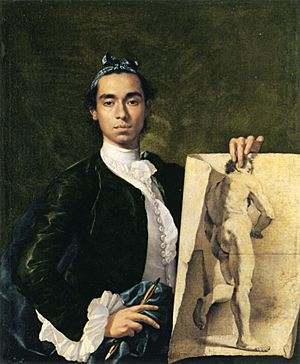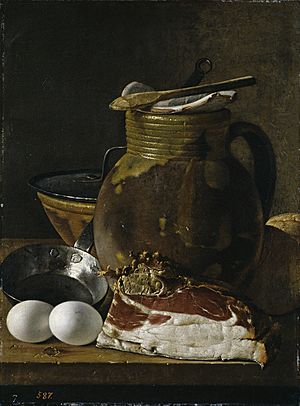Luis Egidio Meléndez facts for kids
Quick facts for kids
Luis Egidio Meléndez
|
|
|---|---|

Self-portrait, oil on canvas, 1747, Musée du Louvre
|
|
| Born |
Luis Egidio Meléndez de Rivera Durazo y Santo Padre
1716 |
| Died | 1780 (aged 63–64) |
| Nationality | Spanish |
| Known for | Painting |
Luis Egidio Meléndez (1716–1780) was a famous Spanish painter. He is known as the best Spanish still-life painter of the 1700s. Still-life paintings show everyday objects like food or kitchen items. Meléndez was amazing at making these ordinary things look powerful and real. He was very good at using light and showing how objects felt and looked. Even though he was very talented, he was not well-known during his lifetime and died without much money.
Contents
Early Life and Training
Luis Egidio Meléndez was born in Naples in 1716. His father, Francisco Meléndez, was a painter who specialized in tiny paintings called miniatures. Francisco had moved to Italy to learn more about art.
When Luis was just one year old, his family moved back to Madrid, Spain. Luis and his siblings, José Agustín and Ana, learned to paint from their father. In 1725, their father became the King's Painter of Miniatures.
Luis later worked in the studio of Louis Michel van Loo, a French artist who was the royal painter for King Philip V of Spain. Luis helped copy royal portraits. He hoped to become a court painter himself.
Art Academy and Challenges
In 1744, a new art school called the Real Academia de Bellas Artes de San Fernando opened. Luis's father became an honorary director there, and Luis was one of the first students. He was very good at drawing. This academy was special because it encouraged all types of art, even still-life paintings.
Luis was already a skilled painter, as shown by his self-portrait from 1747. However, his father had a big argument with the academy's director. Luis was asked to deliver some harsh letters from his father to the academy. Because of this, his father lost his teaching job, and Luis was officially kicked out of the academy in 1748.
Without the academy's support, Luis decided to go to Italy. He stayed in Rome and Naples until 1752. While there, he painted some works for Charles III of Spain, who was then the King of Naples. These paintings are now lost.
Painting Career

In 1753, a fire at the Alcázar of Madrid destroyed many old choir books. Luis's father convinced him to return to Spain to help paint new miniatures for these books.
Even though Luis painted many still lifes for the royal family, he never got an official job as the king's painter. In 1760, his request to become a court painter was turned down.
After 1760, Luis started to focus mostly on still-life paintings. This type of art was popular and could be sold without needing a special order from the king. Between 1759 and 1772, he created at least 44 still lifes for the private collection of the Prince of Asturias, who later became King Charles IV of Spain. Thirty-nine of these paintings are now in the Museo del Prado in Spain. It is rare to find his work outside of Spain.
Despite his amazing talent, Luis Meléndez lived in poverty for most of his life. In 1772, he wrote a letter to the king saying that all he owned were his pencils. He died in Madrid in 1780, still very poor and not fully appreciated for his art.
Meléndez's Still-Life Style
Meléndez made Spanish still-life painting even better. He followed the style of earlier artists like Juan Sánchez Cotán and Francisco de Zurbarán. Like them, Meléndez carefully studied how light affected objects. He also focused on the texture and color of fruits, vegetables, and kitchen items like clay pots and copper pans.
However, Meléndez brought his subjects closer to the viewer. He painted them from a lower angle. This made people feel like they could really examine the objects themselves. This was part of the new ideas of the Age of Enlightenment, which encouraged people to explore and learn about the world.
Meléndez painted everyday things with great care and respect. He loved showing the normal shapes of objects. Each of his still-life paintings is eye-catching and shows his amazing skill in arranging things. He made objects look solid and real. He used strong lighting to make them stand out.
It seems Meléndez spent a lot of time setting up the lighting for his paintings. He loved painting reflections on the shiny surfaces of lemons, copper pots, and ceramic bowls. This makes his paintings feel lively and rhythmic. Meléndez himself described his works as "an amusing cabinet with all types of foodstuffs that the Spanish climate produces."
Images for kids
-
Still Life with Salmon, Lemon and three Vessels, oil on canvas, 1772 Museo del Prado
-
The Afternoon Meal, circa 1772, Metropolitan Museum of Art
See also
 In Spanish: Luis Egidio Meléndez para niños
In Spanish: Luis Egidio Meléndez para niños












